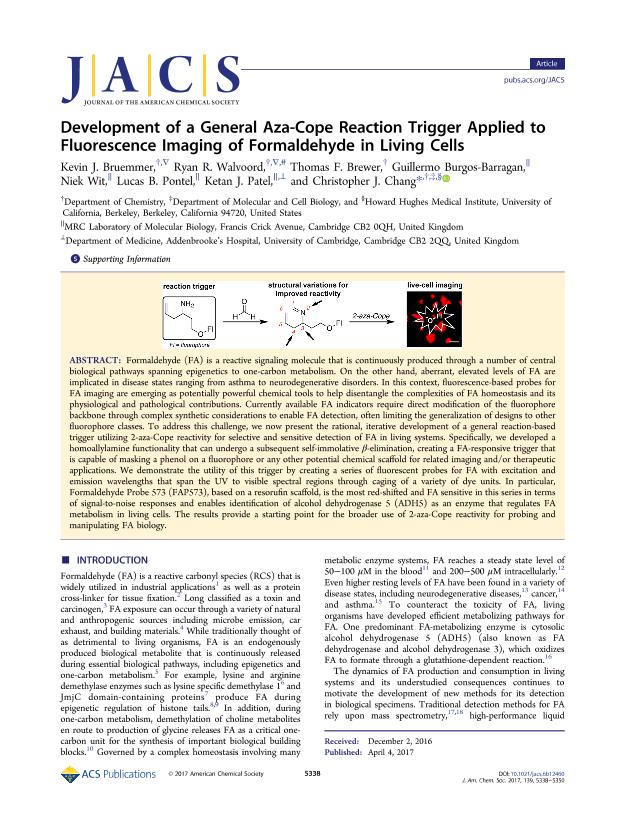Mostrar el registro sencillo del ítem
dc.contributor.author
Bruemmer, Kevin J.
dc.contributor.author
Walvoord, Ryan R.
dc.contributor.author
Brewer, Thomas F.
dc.contributor.author
Burgos Barragan, Guillermo
dc.contributor.author
Wit, Niek
dc.contributor.author
Pontel, Lucas Blas

dc.contributor.author
Patel, Ketan J.
dc.contributor.author
Chang, Christopher J.

dc.date.available
2018-07-03T18:18:52Z
dc.date.issued
2017-04
dc.identifier.citation
Bruemmer, Kevin J.; Walvoord, Ryan R.; Brewer, Thomas F.; Burgos Barragan, Guillermo; Wit, Niek; et al.; Development of a General Aza-Cope Reaction Trigger Applied to Fluorescence Imaging of Formaldehyde in Living Cells; American Chemical Society; Journal of the American Chemical Society; 139; 15; 4-2017; 5338-5350
dc.identifier.issn
0002-7863
dc.identifier.uri
http://hdl.handle.net/11336/51061
dc.description.abstract
Formaldehyde (FA) is a reactive signaling molecule that is continuously produced through a number of central biological pathways spanning epigenetics to one-carbon metabolism. On the other hand, aberrant, elevated levels of FA are implicated in disease states ranging from asthma to neurodegenerative disorders. In this context, fluorescence-based probes for FA imaging are emerging as potentially powerful chemical tools to help disentangle the complexities of FA homeostasis and its physiological and pathological contributions. Currently available FA indicators require direct modification of the fluorophore backbone through complex synthetic considerations to enable FA detection, often limiting the generalization of designs to other fluorophore classes. To address this challenge, we now present the rational, iterative development of a general reaction-based trigger utilizing 2-aza-Cope reactivity for selective and sensitive detection of FA in living systems. Specifically, we developed a homoallylamine functionality that can undergo a subsequent self-immolative β-elimination, creating a FA-responsive trigger that is capable of masking a phenol on a fluorophore or any other potential chemical scaffold for related imaging and/or therapeutic applications. We demonstrate the utility of this trigger by creating a series of fluorescent probes for FA with excitation and emission wavelengths that span the UV to visible spectral regions through caging of a variety of dye units. In particular, Formaldehyde Probe 573 (FAP573), based on a resorufin scaffold, is the most red-shifted and FA sensitive in this series in terms of signal-to-noise responses and enables identification of alcohol dehydrogenase 5 (ADH5) as an enzyme that regulates FA metabolism in living cells. The results provide a starting point for the broader use of 2-aza-Cope reactivity for probing and manipulating FA biology.
dc.format
application/pdf
dc.language.iso
eng
dc.publisher
American Chemical Society

dc.rights
info:eu-repo/semantics/openAccess
dc.rights.uri
https://creativecommons.org/licenses/by/2.5/ar/
dc.subject
Formaldehyde
dc.subject
Aza-Cope Reaction
dc.subject
Cells
dc.subject
Endogenous
dc.subject.classification
Otras Ciencias Biológicas

dc.subject.classification
Ciencias Biológicas

dc.subject.classification
CIENCIAS NATURALES Y EXACTAS

dc.title
Development of a General Aza-Cope Reaction Trigger Applied to Fluorescence Imaging of Formaldehyde in Living Cells
dc.type
info:eu-repo/semantics/article
dc.type
info:ar-repo/semantics/artículo
dc.type
info:eu-repo/semantics/publishedVersion
dc.date.updated
2018-06-19T15:52:49Z
dc.identifier.eissn
1943-2984
dc.journal.volume
139
dc.journal.number
15
dc.journal.pagination
5338-5350
dc.journal.pais
Estados Unidos

dc.journal.ciudad
Washington DC
dc.description.fil
Fil: Bruemmer, Kevin J.. University of California at Berkeley; Estados Unidos
dc.description.fil
Fil: Walvoord, Ryan R.. University of California at Berkeley; Estados Unidos
dc.description.fil
Fil: Brewer, Thomas F.. University of California at Berkeley; Estados Unidos
dc.description.fil
Fil: Burgos Barragan, Guillermo. Medical Research Council. Laboratory of Molecular Biology; Reino Unido
dc.description.fil
Fil: Wit, Niek. Medical Research Council. Laboratory of Molecular Biology; Reino Unido
dc.description.fil
Fil: Pontel, Lucas Blas. Consejo Nacional de Investigaciones Científicas y Técnicas. Oficina de Coordinación Administrativa Parque Centenario. Instituto de Investigación en Biomedicina de Buenos Aires - Instituto Partner de la Sociedad Max Planck; Argentina. Medical Research Council. Laboratory of Molecular Biology; Reino Unido
dc.description.fil
Fil: Patel, Ketan J.. University of Cambridge; Reino Unido. Medical Research Council. Laboratory of Molecular Biology; Reino Unido
dc.description.fil
Fil: Chang, Christopher J.. University of California at Berkeley; Estados Unidos
dc.journal.title
Journal of the American Chemical Society

dc.relation.alternativeid
info:eu-repo/semantics/altIdentifier/doi/http://dx.doi.org/10.1021/jacs.6b12460
dc.relation.alternativeid
info:eu-repo/semantics/altIdentifier/url/https://pubs.acs.org/doi/abs/10.1021/jacs.6b12460
Archivos asociados
